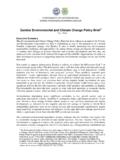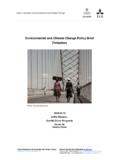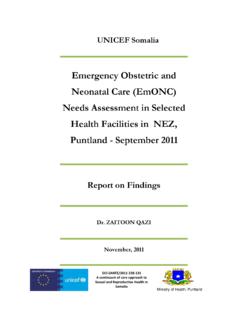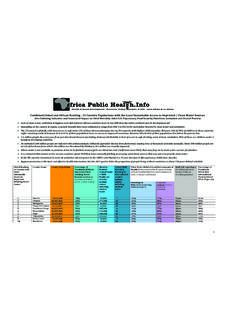Transcription of Environmental and Climate Change Policy Brief …
1 Sida's Helpdesk for Environment and Climate Change Contact: name and e-mail Team Leader: Anders Ekbom Quality Manager: Eva Stephansson Environmental and Climate Change Policy Brief somalia Photo: Somali Center for water and Environment 2012-10-28 Anja-Christina Beier Eva Stephansson ii Executive Summary This environment and Climate Change Policy Brief aims at briefly presenting key Environmental sustainability challenges and opportunities in somalia , their linkages to poverty reduction and the millennium development goals three, four and five. It is a light version and does not contain in-depth analysis. The key Environmental challenges in somalia are several and are related to deforestation, land degradation, increasing aridity and overgrazing, water scarcity, waste disposal, Climate Change and ecosystem services. These challenges cause negative trends to poverty, health, economy and ecological and human resilience.
2 Climate Change is expected to add to already existing stresses. The key poverty-environment linkages in somalia are related to: increased conflict and general instability particularly related to further marginalisation of vulnerable men and women; lack of secure tenure to land and other natural resources; vulnerability to natural disasters and resilience; polluted water and waste disposal especially along coastland destructive to health; unreliable access to food and water leading to malnutrition and famine; low ability of particularly female-headed households to accumulate assets including land; and access to forest produce for monetary income. Women and girls are disproportionately at risk due to gender roles and inequalities. Corruption is an issue holding back the development of somalia and is a dilemma also affecting further Environmental degradation or an Environmental recovery.
3 Somali men and women have different and unequal access to agriculture, livestock and fisheries production inputs and technology. They also experience vulnerabilities differently and resort to distinct coping strategies. Female Headed Households (FHH) among Somali populations experience higher vulnerability to shocks related to livestock losses relative to male headed households in the same wealth groups. Women and girls are often the ones responsible for collecting water, an assignment that gets more difficult when water gets degraded. It is also a highly security issue as many women and girls are becoming victims to violence. Children s health and nutritional well-being are strongly linked to their access to safe water and proper sanitation. Lack of sanitation, safe water facilities and services and poor hygiene are significant contributors to the high rates of disease in somalia .
4 A comprehensive approach to reducing malnutrition and disease must include increasing access to sanitation and safe water services and addressing hygiene behaviour. Maternal Health in somalia is worse than in almost any other country in the world. A major problem is the infrastructure, transport facilities and distance to professional medical assistance as well as the access to safe water and sufficient and adequate nutrition. A key concern relating to sound Environmental management relates to the adoption and effective enforcement of a suite of international, regional and national agreements which define the country s own responsibilities. The regulatory framework for most of somalia is poorly developed, although the country has had signed a number of important international conventions. While there is a clear need for a thorough revision of the country s national legislation on management of natural resources, it will require considerable effort and co-operation from all interested parties.
5 The list of problems and challenges in somalia can be made very long, however there are also positive aspects to grasp; despite the collapse of the public sector, people have shown remarkable resilience, and an energetic and engaged private sector and vibrant civil society iii have emerged, as for example in communications and money transfers, transportation and import/exports. Not least in the light of a newly elected parliament, a new presidency and a new constitution there are opportunities for somalia . The transition process lying ahead of the Somali people will be a good window of opportunity to find ways to combat Environmental degradation in order to act for poverty reduction. iv Contents Executive Summary .. ii 1. Introduction .. 1 2. Key Environmental Challenges .. 2 3. Effects of the Environmental challenges .. 5 Impacts on Poverty .. 5 Impacts on Public Health.
6 7 Impacts on Food Security and nutrition .. 8 Impacts on Economic development .. 9 Resilience .. 10 4. Millennium Development Goals .. 12 Goal 3. Promote gender equality and empower women .. 12 Goal 4. Reduce child mortality .. 14 Goal 5. Improve maternal health .. 15 5. Policy Framework to manage Environmental challenges .. 16 Key actors .. 16 Governance, implementation and enforcement .. 17 6. Conclusions .. 19 7. Recommendations to Sida .. 20 References .. 22 Annexes .. 25 Annex 1 .. 25 Annex 2 MDG reference for somalia .. 26 1 1. Introduction This Environmental and Climate Change Policy Brief1 has been written as an input to the Swedish results strategy process in preparation of a revised strategy document for somalia . It aims at briefly presenting key Environmental sustainability challenges and opportunities in somalia , and focuses on the millennium development goals 3, 4, and 5.
7 The analysis was conducted as a desk study during end of October and beginning November and is based on selected reports, research papers and statistics. It has been written as a light version as the time constrain has been significant, therefore this is only a first draft. In the case of somalia it has to be noted that statistics and reports are not always comprehensive or existent, which also shapes this desk study in the sense that there may be discrepancies in statistics and figures may not be up to date. However, some of the statistical data on somalia is currently collected and disseminated by a number international agencies and NGOs; but such data collection is mostly guided by the needs and priorities of external actors linked to their areas of intervention rather than the national needs and priorities of somalia . The Swedish Government has identified environment and Climate Change as one of three thematic priorities for development cooperation.
8 This is reinforced in the Swedish Policy on environment and Climate Change in development cooperation concluding that these aspects are a central point of departure for all development cooperation 2. The Policy further requires that Environmental impacts, effects of Climate Change and associated risks are assessed and integrated in analysis, planning, strategies, implementation and follow-up in Swedish development cooperation. The previous country strategy3 is based on a combination of humanitarian assistance and support for reconstruction. The humanitarian assistance was aimed at mitigating the effects of the humanitarian disaster. The reconstruction programmes were designed to lend support to the regional and local peaceful political structures which have grown up and to contribute to poverty reduction efforts. For the forthcoming strategy period focus is set on women and children as well as their resilience and a development towards transparent and participative governance.
9 1 This Environmental and Climate Change Policy Brief was written, at the request of Sida (Urban Sj str m) by Anja-Christina Beier and Eva Stephansson at Sida s Helpdesk for Environment and Climate Change . The views expressed in this Environmental and Climate Change Policy Brief are those of the authors and do not necessarily represent the views of Sida. 2 Swedish Government Offices, 2009 3 Country strategy for development cooperation somalia January 2003 December 2005 Development assistance to somalia 2 2. Key Environmental Challenges somalia is one of the poorest and least developed countries in the world and as such presents exceptional challenges in terms of natural resource management. As a result of more than 25 years of civil unrest, somalia s governance structures have fallen apart, and militias control different parts of the country.
10 In addition, the regions of Somaliland and Puntland have unilaterally declared somalia has five main World Ecosystem types: Coastal Aquatic (11 percent), Desert and Semi-Desert (38 percent), Grass and Shrub (36 percent), Crop and Settlements (one percent), and Interrupted Woods (14 percent).5 The three main productive sectors are livestock, charcoal production and crops. Livestock (mainly live animals and some products) is the largest export with charcoal production ranking second. Fifty-nine percent of the population practice nomadic and semi-nomadic agro-pastoralism, followed by 17 percent made up by Food insecurity and livelihoods, lack of marine and coastal management, probable hazardous waste, and the mitigation and management of Environmental degradation along with natural disasters are Environmental concerns. The key Environmental challenges in somalia are related to women and children, natural resource degradation and democratic instability.










